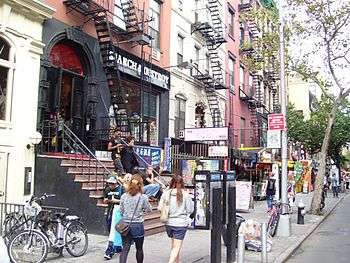8th Street / St. Mark's Place (Manhattan)
|
St. Mark's Place in 2010 | |
| Other name(s) | St. Mark's Place |
|---|---|
| Maintained by | New York City Department of Transportation |
| Length | 1.3 mi[1][2] (2.1 km) |
| Location | Manhattan, New York City |
| Postal code | 10011, 10003, 10009 |
| West end | Sixth / Greenwich Avenues in West / Greenwich Villages |
| East end | Avenue D in East Village |
| North | 9th Street |
| South |
Waverly Place (6th Avenue to Broadway) 7th Street (Bowery to Avenue D) |
| Construction | |
| Commissioned | March 1811 |
8th Street is a street in the New York City borough of Manhattan that runs from Sixth Avenue to Third Avenue, and also from Avenue B to Avenue D; its addresses switch from West to East as it crosses Fifth Avenue. Between Third Avenue and Avenue A, it is named St. Mark's Place, after the nearby St. Mark's Church in-the-Bowery on 10th Street at Second Avenue.
St. Mark's Place is considered a main cultural street for the East Village. Vehicular traffic runs east along both one-way streets. St. Mark's Place features a wide variety of retailers. Venerable institutions lining St. Mark's Place include Gem Spa, Grassroots Tavern, the St. Mark's Hotel, St. Mark's Comics, and the Holiday Cocktail Lounge. There are several open front markets that sell sunglasses, clothing and jewelry. In her 400-year history of St. Mark's Place (St. Marks Is Dead), Ada Calhoun called the street "like superglue for fragmented identities" and that "the street is not for people who have chosen their lives ... [it] is for the wanderer, the undecided, the lonely, and the promiscuous."[3]
History
Early years
Wouter van Twiller, colonial governor of New Amsterdam, once owned a tobacco farm near 8th and Macdougal Streets. Such farms were located around the area until the 1830s.[4] Nearby, a Native American trail crossed the island via the right-of-ways of Greenwich Avenue, Astor Place, and Stuyvesant Street.[4]
Under the Commissioners' Plan of 1811, a city grid for much of Manhattan was defined. Eighth Street was to run from Sixth Avenue in the west to Third Avenue and the Bowery to the east. The area west of Sixth Avenue was already developed as Greenwich Village. Mercer, Greene, Wooster, Thompson Street, Sullivan Street, and Macdougal Streets, as well as Laurens Street (present-day LaGuardia Place), extended to Eighth Street until the 1820s, when the construction of Washington Square Park severed Laurens, Thompson, and Sullivan Streets south of 4th Street.[4]
19th century
After the Commissioners' Plan was laid out, property along the street's right of way quickly developed. By 1835, the New York University opened its first building, the Silver Center, along Eighth Street near the Washington Square Park. Row houses were also built on Eighth Street. The street ran between the Jefferson Market, built in 1832 at the west end, and the Tompkins Market, built in 1836, at the east end. These were factors in the street's commercialization in later years.[4]
Eighth Street was supposed to extend to a market place at Avenue C, but since that idea never came to fruition. Capitalizing on the high-class status of Bond, Bleecker, Great Jones, and Lafayette Streets in NoHo, developer Thomas E. Davis developed the east end of the street and renamed it "St. Mark's Place".[5] Davis built up St. Mark's Place between Third and Second Avenues between 1831 and 1832. Although the original plan was for Federal homes, only three such houses remained in 2014.[5]
Meanwhile, Eighth Street became home to a literary scene. At Astor Place and Eighth Street, the Astor Opera House was built by wealthy men and opened in 1847.[6] Publisher Evert Augustus Duyckinck founded a private library at his 50 East Eighth Street home. Ann Lynch started a famous literary salon at 116 Waverly Place and relocated to 37 West Eighth Street in 1848.[4] Around this time and up until the 1890s, Eighth Street was co-named Clinton Place in memory of politician DeWitt Clinton, whose widow lived along nearby University Place.[4]
In the 1850s, Eighth Street housed an educational scene as well. The Cooper Union for the Advancement of Science and Art, a then-free institution for art, architecture and engineering education, was opened in 1858. The Century Club, an arts and letters association, relocated to 46 East Eighth Street around that time; the Bible House of the American Bible Society, was nearby. In addition, the Brevoort Hotel, as well as a marble mansion built by John Taylor Johnston, were erected at Fifth Avenue and Eighth Street.[4]
At the same time, German immigrants moved into the area around Tompkins Square Park. The area around St. Mark's Place was nicknamed Kleindeutschland, or "Little Germany", because of a huge influx of German immigrants in the 1840s and 1850s. Many of the homes turned into boarding houses, as the area had 50,000 residents but not a lot of real estate. Tenement housing was also built on St. Mark's Place.[5]
By the 1870s, apartments replaced stables and houses along the stretch of Eighth Street west of Macdougal Street. The elevated Third and Sixth Avenue Lines were also built during that time, with stops along the former at Ninth Street and along the latter at Eighth Street.[4][5]
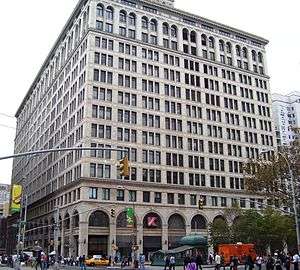
At the southwest corner of Broadway and Eighth Street, the street's first commercial building was built. By the 1890s, buildings on the stretch from Bowery to Fifth Avenue were used for trade.[4] In 1904, the Wanamaker's Department Store opened at the former A.T. Stewart store along Broadway between 9th and 10th Streets, with an annex built at Eighth Street.[4]
20th century
In the early 1900s, Little Germany was shrinking. At the same time, Jews, Hungarians, Poles, Ukrainians, and Russians from Eastern Europe started moving in. At this point, St. Mark's Place was considered a part of the Lower East Side.[5]
On the western stretch of Eighth Street, an art scene was growing. Gertrude Vanderbilt Whitney, Daniel Chester French, and other artists moved in the stables at Macdougal Alley at this time. By 1916, a studio complex for artists replaced most of these stables, making the areas around Eighth Street popular for bohemians. Whitney, a patron for other American painters, combined four houses on West Eighth Street houses into the Whitney Museum in 1931.[4]
The 1927 construction of the skyscraper at One Fifth Avenue, as well as the Eighth Street Playhouse movie theater, helped influence development on the Sixth Avenue end of the street, where construction of the IND Eighth Avenue Line had required destruction of many buildings there.[4] On an adjoining block, the Women's House of Detention was built in Jefferson Market complex in 1929–1932 and existed through the 1970s.[4]
In the 1930s, after Prohibition ended, West Eighth Street became an entertainment area. Around that time, the New York School movement for abstract expressionist painters was centered around Eighth Street, with many such painters moving to Eighth Street.[4]
After World War II, property along 8th Street was converted to apartment houses. The Rhinelander Estate, one of the major landowners on Eighth Street, erected a building between Washington Square North, Fifth Avenue, West Eighth Street, and the Whitney Museum site. Sailor's Snug Harbor, the other major land owner, demolished the blocks from Fifth Avenue to Broadway on the north side of Eighth and Ninth Streets, including the popular Brevoort Hotel. It replaced these blocks mainly with low-rise apartment buildings and stores, as well as two high-rises.[4] Around this time, West Eighth Street was also becoming the location of neighborhood commerce.[4]
After the elevateds were demolished in the 1940s and 1950s, the real estate industry tried to entice residents to the St. Mark's Place area, describing the neighborhood as "East Village". This area became home to an underground scene, and as it was far from public transportation, it became rundown. A 1965 Newsweek article described the East Village by telling readers to "head east from Greenwich Village, and when it starts to look squalid, around the Bowery and Third Avenue, you know you're there."[5]
In the 1960s, Macdougal and West Eighth Streets, as well as St. Mark's Place, became a popular area for hippies.[5] A women's clothing store, a pharmacy, and bookstores were replaced by fast food restaurants and other shops, directed toward the area's tourism base.[4] By 1968, St, Mark's Place became a stopping point for tour buses, which formerly skipped the area.[5]
In 1980, hot dog company Nathan's Famous moved into the location of a former bookstore on Eighth Street, to the anger of some Greenwich Village residents. However, other establishments, such as the B. Dalton bookstore, clothing stores, and shoe stores, started to attract tourists to the area.[4] By the 1990s, the areas around both Eighth Street and St. Mark's Place were becoming rapidly gentrified, with new buildings and establishments being developed along both streets.[5] The Village Alliance Business Improvement District was formed in 1993 to care for the area around Eighth Street.[4]
Notable buildings and sites
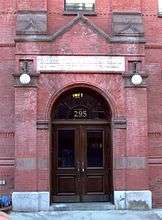
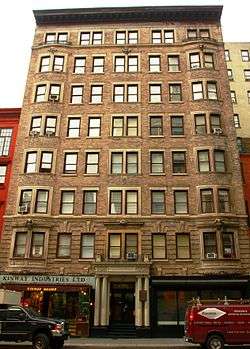
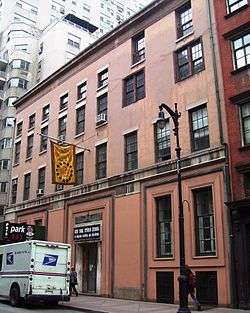
8th Street
East
- 127 Avenue B, also known as 295 East 8th Street, on Tompkins Square Park, was originally the Tompkins Square Lodging House for Boys and Industrial School. It was designed by Vaux & Radford and built in 1887. The building later became the Children's Aid Society Newsboy and Bootblacks Lodging House, and was briefly a synagogue, Talmud Torah Darchei Noam. The building was restored in 2006, and is now apartments.[7] The building was featured prominently in the 2002 film In America (film)
- The stucco-faced apartment building at 4–26 East 8th Street between Fifth Avenue and University Place was built in 1834–36 and remodeled in 1916. It was designed by Harvey Wiley Corbett, and has been described as a "stage set, symbolic of the 'village' of a bohemian artist.'[8]
- The residential apartment building at One Fifth Avenue, on the southeast corner of East 8th Street, was built in 1929 and was designed by Helme, Corbett & Harrison and Sugarman & Berger. The brown brick building features numerous step-backs, battlements, buttresses and other suggestions of medieval architecture.[8]
- The full-block building on 8th Street bordered by Lafayette Street, 9th Street and Broadway, which carries the addresses 499 Lafayette Avenue and 770 Broadway, was built in 1902 to be the Annex for the giant John Wanamaker's Department Store located one block north between 9th and 10th Streets. The two buildings were connected by a skybridge over 9th Street which was dubbed the "Bridge of Progress".[9][10] The main store was destroyed by fire in 1955, but the Annex building remains, and currently houses a Kmart and a GAP retail stores, as well as offices.
- Across the street, also between Lafayette Street and Broadway, 8th Street runs behind Clinton Hall at 13 Astor Place, also known as 21 Astor Place. This was once the site of the Astor Opera House outside of which the Astor Place Riot occurred. The Opera House opened in 1847 and closed in 1890 to be replaced by the current building, designed by George E. Harney, which became the site of the New York Mercantile Library. The library left the 11-story building in 1932, and it has since been a union headquarters (District 65 of the Distributive Workers of America), the Astor Place Hotel, and, as of 1995, condominiums.[11][12]
West
- Marlton House at 3–5 West 8th Street between Fifth and Sixth Avenues in Greenwich Village was built in 1900 as the Marlton Hotel, a single room occupancy (SRO) facility. It was notable for its bohemian clientele, but since 1987 it has been used as a dormitory for The New School.
- The three former 1838 row houses at 8–12 West 8th Street between Fifth Avenue and Macdougal Street in Greenwich Village were converted in 1931 by Auguste L. Noel of Noel & Miller into the first home of the Whitney Museum of American Art, which sculptor and heiress Gertrude Vanderbilt Whitney had established in 1929, after the Metropolitan Museum of Art rejected the donation of her extensive collection of contemporary and avant-garde artworks. In 1914, Whitney had started the Whitney Studio at 8 West 8th Street, just behind her own studio on MacDougal Alley. The museum was located here until 1954, when it moved uptown. The building is currently, along with 14 West 8th Street (built in 1900), the New York Studio School of Drawing, Painting and Sculpture.[13]
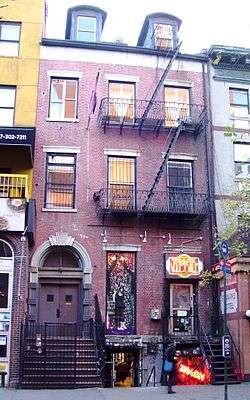
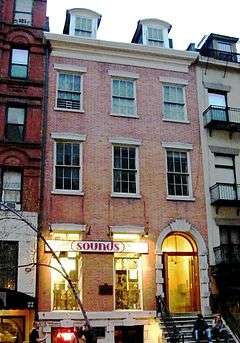

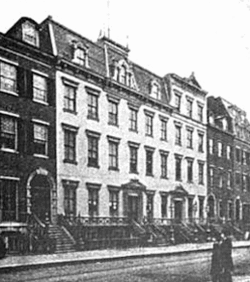
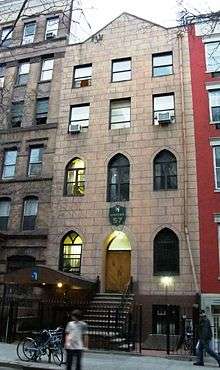

St. Mark's Place
- #2 – Beginning in 1962 it housed The Five-Spot, one of the city's leading jazz clubs. Innovators such as Thelonious Monk, Charlie Parker and Charles Mingus all appeared there. It later became "The Late Show", a vintage clothing store that was popularized by the New York Dolls and owned by their valet, Frenchie.[15] GG Allin also lived in the building.
- #4 – The Hamilton-Holly House was built in 1831 by Thomas E. Davis and sold to Colonel Alexander Hamilton, the son of Alexander Hamilton, first Secretary of the Treasury, in 1833.[16] From 1843 to 1863 it was owned by Isaac C. Van Wyck, the candle and oil merchant. The building was owned from 1863 to 1903 by butter merchant John W. Miller, who added a two-story addition and a meeting hall on the first floor. From 1901 until 1952 the building was owned by the C. Meisel company, a manufacturer of musical instruments. Between 1955 and 1967 it housed the Tempo Playhouse, New Bowery Theatre, and Bridge Theatre, noted for experimental theater, music, dance, and independent film.[16] In 1964 it housed the New Bowery Theatre, a showcase for the American Theatre of Poets. From 1967 it housed Limbo, which in 1975 became Trash and Vaudeville, a punk clothing store.[15][17] The building was designated a New York City landmark in 2004.[14]
- #6 – The Modern School, founded in 1901 in Barcelona by Francesco Ferrer, opened a New York branch here in January 1911. It was led by anarchists Emma Goldman and Alexander Berkman, who founded the Francisco Ferrer Association in 1910, "to perpetuate the work and memory of Francisco Ferrer", who had been executed in October 1909 for plotting to kill Alfonso XIII, the King of Spain, and masterminding the events of Tragic Week, a mass riot in and around Barcelona.[18] Beginning in 1913 the building housed the Saint Marks Russian and Turkish Baths. In 1979 the building was renovated and renamed the New Saint Marks Baths, a gay bath house.[19] The New Saint Marks Baths was closed by the New York City Department of Health in 1985, due to concerns of HIV transmission. The building subsequently housed a Kim's Video and Music location, until early 2009. Since 2014, the building has been home to one of six Barcade locations.
- #8 – The New York Cooking School, founded by Juliet Corson in 1876, was the country's first cooking school. It figured prominently in the city's first known Mafia hit in Manhattan, the 1888 killing of Antonio Flaccomio, when it was La Triniria Italian Restaurant. The killer dined there with his victim, then stabbed him a few blocks away.[15]
- #11 – Home to Shulamith Firestone, feminist, activist, author of The Dialectic of Sex: The Case for Feminist Revolution and Airless Spaces, in the seventies and eighties.
- #12 – Designed by William C. Frohne and built in 1885, as the clubhouse for the Deutsch-Amerikanische Schützen Gesellschaft (German-American Shooting Society). The facade says Einigkeit macht stark (Unity is strength). The building is a remnant of Kleindeutschland (Little Germany), the home of many German immigrants from the mid-19th Century until the General Slocum disaster of June 15, 1904.[20] The building was designated as a landmark in 2001.[14] This was the original location of the St. Mark's Bookshop,[19] before it moved across the street. In the late seventies it housed The New Cinema, featuring film and video by independent filmmakers, including Eric Mitchell, Anders Grafstrom, Scott and Beth B, Jim Jarmusch, Charles Ahearn and Amos Poe.
- #13 – Home to Lenny Bruce in the mid-1960s.[15] Sylvain Sylvain, guitarist for the New York Dolls, lived in the basement apartment in the mid 70s. The main floor and basement of the building were for many years St. Mark's Bookshop,[19] now around the corner, at 31 3rd Avenue.
- #15 – Former location of "Paul McGregor's Haircutter." McGregor was known for inventing the shag, which he gave to Jane Fonda. Other customers were Warren Beatty, Goldie Hawn and Faye Dunaway. Supposedly, Beatty's film Shampoo was based on McGregor.[21][22] From 1995 to 1999, the building was home to Coney Island High, a live music venue notable for being the location of No Doubt's first ever New York City performance..
- #17 – Site of the first Hebrew-Christian Church in America, in 1885.[15]
- #19–25 – As Arlington Hall, this was the site of a 1914 shootout between "Dopey" Benny Fein's Jewish gang and Jack Sirocco's Italian mob, an event that marked the beginning of the predominance of the Italian American gangsters over the Jewish American gangsters. Arlington Hall also had some notable speakers including Police Commissioner Theodore Roosevelt (1895) and William Randolph Hearst (1905). The building later housed the Dom Restaurant, with its well-known Stanley's Bar – where The Fugs played in the mid-1960s – Andy Warhol and Paul Morrissey turned The Dom into a nightclub in 1966, which served as a showcase for the Exploding Plastic Inevitable, Warhol's multimedia stage show for the Velvet Underground. In early 1967, the Dom morphed yet again into The Balloon Farm. Later that year, the lease was transferred to Brandt Freeman International, LTD, and renamed the Electric Circus.[23] Also site of CBGB retail store to 2008.[24]
- #20 – The Daniel LeRoy House was built as part of an elegant row of houses in 1832, of which this Greek Revival building is the only survivor. It is a New York City Landmark (1969),[14] and is on the National Register of Historic Places[20] Daniel LeRoy was related to the Stuyvesant family and his wife was a member of the eminent Fish family.
- #24 – This was the original location of the Limbo clothing boutique, which opened for business in 1965 and moved to #4 in 1967.[19]
- #27 – In the 19th and early 20th century, this was Children's Aid Society's Girls' Lodging House.[15]
- #28 – From 1967–1971, this storefront housed Underground Uplift Unlimited (UUU), which created and sold some of the most noteworthy protest buttons and posters of era, including "Make Love Not War."[15]
- #30 – Abbie and Anita Hoffman lived in the basement in 1967–68; the Yippies were co-founded with Jerry Rubin there.[15]
- #33 – Home to poet Anne Waldman in the late 1960s/mid-1970s. In 1977, the storefront was occupied by Manic Panic, the first U.S. boutique to sell punk rock attire, which developed its own line of make-up and vibrant hair dyes;[15] notable patrons have included performers David Bowie, Cyndi Lauper, Debbie Harry, and Joey Ramone.
- #34 – Location of the East Side Bookstore, 1960s–1980s.
- #51 – In the early 1980s, this was home to 51X, a gallery that featured graffiti art, representing artists such as Keith Haring, and Jean-Michel Basquiat.[15]
- #52 – Annex to the Hebrew National Orphan Home, founded in 1912; its main entrance was on 7th Street.[15]
- #57 – Club 57 was an important art and performance space in the late 1970s and early 1980s; notable people, such as Ann Magnuson, Keith Haring, Klaus Nomi, John Sex, Kenny Scharf, David Wojnarowicz, Wendy Wild, The Fleshtones, and Fab Five Freddy, performed or showed there.[15]
- #60 – Originally St. Mark's Hospital of New York City; later home of abstract expressionist painter Joan Mitchell, where she lived and painted from 1951 to 1957.[15]
- #75 – The Holiday Cocktail Lounge has had a range of visitors including W. H. Auden, Allen Ginsberg[25] and other Beat writers, Shelley Winters, and Frank Sinatra, whose agent lived in the neighborhood.[15]
- #77 – Home to W. H. Auden for almost 20 years.[25] The basement of this building was the location where the newspaper Novy Mir ("New World" or "New Peace"), a Russian-language Communist paper, was founded in 1916. It was edited by Nikolai Ivanovich Bukharin, and Leon Trotsky worked there; the paper stopped publishing after the Russian Revolution of October 1917.[26]
- #80 – Home of Leon Trotsky.[26] Theatre 80[28] saw the premiere of You're a Good Man, Charlie Brown in 1967. Formerly the Jazz Gallery, site of the last performance by Lord Buckley. Now also the home of The Exhibition of the American Gangster, a museum of the American Gangster[29]
- #85 – The 1871 birthplace of painter and caricaturist Lyonel Feininger.[30]
- #94 – Home of UNDER St. Mark's Theater, an alternative performance venue and black box theater from the 1970s.[31]
- #96 & #98 – The Led Zeppelin album Physical Graffiti features a front and back cover design that depicts these two buildings, which feature carved faces. Keith Richards and Mick Jagger are in front of same building in the Rolling Stones music video "Waiting on a Friend".[15]
- #96 – Once the home of the Anarchist Switchboard, a 1980s punk activist group.
- #101 – From the mid-1970s to 1983, the poets Ted Berrigan and Alice Notley, who were married to each other, lived here. In Berrigan's "The Last Poem", he wrote: "101 St. Mark's Place, apt. 12A, NYC 10009/ New York. Friends appeared & disappeared, or wigged out/ Or stayed; inspiring strangers sadly died; everyone/ I ever knew aged tremendously, except me."[25]
- #102 – Home of independent filmmaker Scott Crary[32]
- #103 – Home of singer/performer Klaus Nomi in the 1970s.
- #104 – Location of the Notre Dame Convent School from 1989 to 2002[33] and is now the site of George Jackson Academy.[34]
- #105 – Early 1860s home of Uriah P. Levy, the first Jewish commodore of the U.S. Navy and who was also known for purchasing Monticello to work toward its restoration and preservation.
- #122 – This building used to be the location of Sin-é, a neighborhood café where Jeff Buckley performed a regular spot on Monday nights. Other musicians such as David Gray and Katell Keineg also performed there. Sin-é closed in the mid-1990s.[35]
Public transportation
- Bus:
- M8 – Eastbound between Avenue A and Sixth Avenue
- Subway stations:
- Astor Place on the IRT Lexington Avenue Line serving the 4 6 <6> trains
- Eighth Street–New York University on the BMT Broadway Line serving the N Q R W trains
- The A B C D E F M trains of the subway stop on Sixth Avenue half a block south of Greenwich Avenue's southeastern end at the West Fourth Street–Washington Square station
- The 1 2 3 trains stop on Seventh Avenue one block north of Greenwich Avenue at the 14th Street station
- The A C E L trains stop on Eighth Avenue and 14th Street half a block north of Greenwich Avenue's northwestern end at the 14th Street–Eighth Avenue station
- The Ninth Street PATH train station on Ninth Street just north of Greenwich Avenue at Sixth Avenue
In popular culture


St. Mark's Place appears in a variety of works in popular culture:
Music
- In the video for The Rolling Stones's "Waiting on a Friend", Mick Jagger and Peter Tosh are seen sitting on the stoop of 96–98 St. Mark's Place; Jagger later mentions 8th Street.
- On the southwest corner of St. Mark's Place and Second Avenue, at 131 Second Avenue, is Gem Spa, a newspaper, magazine and tobacco store, which is known for its fountain egg creams.[36][37] On the back cover of the first, eponymous New York Dolls LP, the band is pictured standing in front of Gem Spa.
- The narrator of Tom Paxton's "Talking Vietnam Potluck Blues", upon smelling marijuana on someone's breath during the Vietnam War remarks, "He smelled like midnight on St. Mark's Place."
- In Andy Warhol's Trash, most of the street scenes of Joe Dallesandro were filmed on St Mark's Place.
- The Holy Modal Rounders mentioned the street in their song "Bad Boy" in the lyric "he'll sell your heart on St. Mark's Place in glassine envelopes/he'll cut it with a pig's heart, and burn the chumps and dopes".
- Earl Slick's 2003 solo album Zig-Zag features a song called "Saint Marks Place".
- In Lou Reed's song "Sally Can't Dance", Sally walks down and lives on St. Mark's Place (in a rent controlled apartment).
- In the King Missile song "Detachable Penis" the search for the missing member ends when the singer states, "Then, as I walked down Second Avenue towards St. Mark's Place / Where all those people sell used books and other junk on the street / I saw my penis lying on a blanket next to a broken toaster oven."
- The album We Are Only Riders by The Jeffrey Lee Pierce Sessions Project features a song called "Saint Marks Place", a duet with Lydia Lunch.
- The music video for Billy Joel's 1986 song "A Matter of Trust" was shot in the Electric Circus building and features extensive footage of the block.
- The Replacements' 1987 song "Alex Chilton" contains the line, "Checkin' his stash by the trash at St. Mark's Place."
- Kirsty McGee's Frost album (2004) contains a song called "Saint Marks Place".
- The Tom Waits song "Potter's Field" from his Foreign Affairs album contains the line "You'll learn why liquor makes a stool pigeon rat on every face that ever left his shadow down on St. Mark's Place."
- The Rank and File song "I Went Walking", on their 1982 album Sundown, presents a cynical look at the St. Mark's Place of that time, containing the lines: "Have you ever seen a sheep in a porkpie hat? Ever see a lemming dressed all in black? Well, you might have been there, but I'll tell you just in case: Just take a walk down St. Mark's Place."
- The Sharp Things album, Foxes and Hounds, features a song called "95 Saint Marks Place".
- The They Might Be Giants song "On The Drag" includes the line "The allure of St. Mark's Place".
- Joe Purdy's song "The City" has a verse, "When we left Brooklyn it was raining so hard. / Come up on 8th and the rain it cleared off. / We're just people watching on 3rd and St. Mark's."
Television
- In the double-episode season six opening episode of Mad Men, "The Doorway", Betty Francis goes to St. Mark's Place to find a girl who has run away after losing her parents, and in season 6, episode 4 ("To Have and To Hold", set in early 1968), Joan Harris and her hometown friend Kate visit the Electric Circus nightclub, located at 19–25 St. Marks Place, during a night out on the town.[38][39]
- In the opening credits to Saturday Night Live (c. 2010), a shot of Cherries adult entertainment store's neon signage is featured in the opening credits.
- In the HBO documentary Dope Sick Love, St. Marks Place features prominently.
- In the season 3 Sex and the City episode "Hot Child In The City", Sarah Jessica Parker's character Carrie goes to get her shoe fixed on St. Mark's Place and ends up dating a man who works at a comic book store on the block. Part of the episode is filmed at the actual St. Mark's Comics.[40]
- In the "The One with the Mugging" episode of Friends, it is revealed that Ross was mugged outside St. Marks Comics as a child. He claims to have been there to buy Spider-Man comic books, but his sister, Monica, intimates it was actually Wonder Woman.
- The second-season finale of the Comedy Central series Broad City is set around the main characters on a night out along St. Mark's Place, and the episode is titled "St. Mark's".
See also
- East Side Hebrew Institute (ESHI)
References
Notes
- ↑ Google (September 1, 2015). "8th Street (west of Tompkins Square Park)" (Map). Google Maps. Google. Retrieved September 1, 2015.
- ↑ Google (September 1, 2015). "8th Street (east of Tompkins Square Park)" (Map). Google Maps. Google. Retrieved September 1, 2015.
- ↑ Calhoun, Ada (2015). St. Marks Is Dead (1st Edition ed.). New York: W.W. Norton & Co. p. 275. ISBN 978-0393240382. Retrieved October 24, 2016.
- 1 2 3 4 5 6 7 8 9 10 11 12 13 14 15 16 17 18 19 Harris, Luther. "Eighth Street History". villagealliance.org. Retrieved August 17, 2015.
- 1 2 3 4 5 6 7 8 9 Nevius, James (September 4, 2014). "The Strange History of the East Village's Most Famous Street". Curbed NY. Retrieved August 17, 2015.
- ↑ Ireland, Joseph Norton (1867). Records of the New York Stage: from 1750 to 1860. 2. T. H. Morrell. p. 515.
- ↑ White, Norval; Willensky, Elliot; Leadon, Fran (2010), AIA Guide to New York City (5th ed.), New York: Oxford University Press, ISBN 9780195383867, p. 201
- 1 2 White, Norval; Willensky, Elliot; Leadon, Fran (2010), AIA Guide to New York City (5th ed.), New York: Oxford University Press, ISBN 9780195383867, p. 134
- ↑ What to See in New York. John Wanamaker, New York. 1912. pp. 22, 31. Retrieved 27 April 2013.
The Wanamaker business occupies two buildings—the fine old structure erected by A. T. Stewart, with its eight floors, and the new Wanamaker Building, occupying the entire block south of the Stewart Building, with sixteen floors. Combined area of the two buildings, about 32 acres. Two large tunnels under and a double-deck bridge over Ninth Street connect the two buildings.
- ↑ Durniak, Drew. "East 9th Street Then and now". The Greenwich Village Society for Historic Preservation. Retrieved 27 April 2013.
By 1955, Wanamaker's sold its northern store property between East 9th and 10th Streets. Before the planned demolition of the building, a fire broke out in 1956 and gutted the structure. In its place was built a huge white-brick-clad residential building called Stewart House in 1960.
- ↑ White, Norval; Willensky, Elliot; Leadon, Fran (2010), AIA Guide to New York City (5th ed.), New York: Oxford University Press, ISBN 9780195383867 p. 157
- ↑ "Clinton Hall" on Forgotten New York
- ↑ New York City Landmarks Preservation Commission; Dolkart, Andrew S. (text); Postal, Matthew A. (text) (2009), Postal, Matthew A., ed., Guide to New York City Landmarks (4th ed.), New York: John Wiley & Sons, ISBN 978-0-470-28963-1, p. 54
- 1 2 3 4 New York City Landmarks Preservation Commission; Dolkart, Andrew S. (text); Postal, Matthew A. (text) (2009), Postal, Matthew A., ed., Guide to New York City Landmarks (4th ed.), New York: John Wiley & Sons, ISBN 978-0-470-28963-1, pp. 65-66
- 1 2 3 4 5 6 7 8 9 10 11 12 13 14 15 "St, Mark's Place: Lot by Lot History" on the Lower East Side History Project website
- 1 2 "Hamilton Holly House" (PDF). Landmarks Preservation Commission. Archived from the original on 14 October 2012. Retrieved 1 May 2012.
- ↑ Van Meter, William, "The Shop That Punk Built", The New York Times (May 9, 2013)
- ↑ "Modern School Collection, Manuscript Collection 1055, Special Collections and University Archives". Rutgers University Libraries. Retrieved 1 May 2012.
- 1 2 3 4 "8th Street" on New York Songlines. Accessed:2011-02-21
- 1 2 White, Norval & Willensky, Elliot (2000), AIA Guide to New York City (4th ed.), New York: Three Rivers Press, ISBN 978-0-8129-3107-5
- ↑ Kleinfield, N. R. "On the Street of Dreams", The New York Times (November 22, 1992)
- ↑ Bay, Cody. "Cinemode: Klute" On This Day in Fashion
- ↑ "19–25 St. Mark's Place" on the Lower East Side History Project website
- ↑ Dodero, Camille (2008-03-25). "CBGB St. Mark's Shop Closing at the End of June". Blogs.villagevoice.com. Retrieved 2014-03-03.
- 1 2 3 "A Literary Tour of the East Village" on the The Local East Village weblog of The New York Times (October 19, 2010). Accessed: 2011-02-21
- 1 2 "77 St. Mark's Place" on the Lower East Side History Project website. Accessed:2011-02-21
- ↑ http://www.nydailynews.com/news/politics/rent-damn-high-party-head-eviction-suit-nixed-article-1.2096701
- ↑ "Welcome". Theatre 80. Retrieved 2014-03-03.
- ↑ "Museum of the American Gangster 80 St Marks PL NY, NY 10003 (212)228-5736 | An exploration into Organized Crime in America". Museumoftheamericangangster.org. Retrieved 2014-03-03.
- ↑ Hess, Hans (1961). Lyonel Feininger. New York: Abrams. p. 1. Retrieved 2015-01-11.
- ↑ "Info" on the UNDER St. Marks website. Accessed:2011-02-21
- ↑ Staff. Notable Addresses. MobileReferences. Retrieved 2013-11-07.
- ↑ NDS. "School History". Notre Dame School website. Retrieved 2007-08-01.
- ↑ "About GJA" on the George Jackson Academy website
- ↑ A Short History of Sin-e, accessed December 21, 2006
- ↑ Berger, Joseph. "The Pizza Is Still Old World, Only Now the Old World Is Tibet", The New York Times (July 31, 2005). Quote: "For New Yorkers, this was the nectar of a Jewish neighborhood, and Gem Spa was the drink's sacred temple, certified as such by magazines and travel writers."
- ↑ Berkon, Ben. "Gem Spa: Classic egg creams in New York" on NewYork.com
- ↑ Matt Zoller Seitz (April 22, 2013). "Mad Men Recap: The Electric Circus". Vulture.
- ↑ Alex Ross (April 21, 2013). "The Rest is Noise: Electric Circus, Electric Ear". The New Yorker.
- ↑ "Tour the Top 25 'Sex and the City' Locations" on Fodors.com
Further reading
- Calhoun, Ada (2015). St. Marks Is Dead: The Many Lives of America’s Hippest Street. W. W. Norton & Company. ISBN 978-0-393-24038-2.
External links
| Wikimedia Commons has media related to 8th Street / St. Mark's Place. |
- Greenwich Avenue: A New York Songline - virtual walking tour
- "St. Marks Place" at the Lower East Side History Project
- 8th Street/St Marks Place: New York Songlines – A history of buildings and establishments along 8th Street and St Marks Place.
- Lower East Side Preservation Initiative
